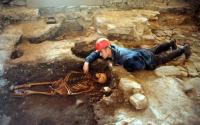Skeleton Reveals Violent Life and Death of Medieval Knight
Below is a news article from The Telegraph. Click here to view the original article.
A 620-year-old skeleton discovered under the floor of Stirling Castle has shed new light on the violent life of a medieval knight.
By Auslan Cramb, Scottish Correspondent
 Archaeologists believe that bones found in an ancient chapel on the site are those of an English knight named Robert Morley who died in a tournament there in 1388.
Archaeologists believe that bones found in an ancient chapel on the site are those of an English knight named Robert Morley who died in a tournament there in 1388.
Radio carbon dating has confirmed that the skeleton is from that period, and detailed analysis suggests that he was in his mid-20s, was heavily muscled and had suffered several serious wounds in earlier contests.
He appears to have survived for some time with a large arrowhead lodged in his chest, while the re-growth of bone around a dent in the front of his skull indicates that he had also recovered from a severe blow from an axe.
He eventually died when he was struck by a sword that sliced through his nose and jaw. His reconstructed skull also indicates that he was lying on the ground when the fatal blow was delivered.
The knight was laid to rest under the stone-flagged floor of a chapel near the castle’s royal apartments and his skeleton was excavated along with 11 others in 1997.
However, it was only recently re-examined following advances in laser scanning techniques that not only revealed the nature of the three wounds, but also showed that the knight had lost teeth, probably from another blow or from falling from his horse.
Gordon Ewart, of Kirkdale Archaeology, which carried out the excavation for Historic Scotland, said: “This is a remarkable and important set of discoveries.
“At first we had thought the arrow wound had been fatal but it now seems he had survived it and may have had his chest bound up.”
Mr Ewart said that Morley was by far the most likely candidate. His skeleton also shows the effects of riding on the ankles and muscle injuries caused by lifting heavy loads.
His sturdy upper body and upper right arm are consistent with wielding heavy swords, and his injuries suggest a hard life of hunting, jousting and foot tournaments.
Richard Strachan, Historic Scotland’s senior archaeologist, added: “Radio carbon dating is not an exact science, but the date we came up with for this skeleton was 1390. That’s only two years difference and quite possible.
“We have been able to look at this skeleton with the benefit of new technology and techniques we didn’t have available in 1997. The key may be the teeth analysis. This will hopefully tell us exactly where this person was born and brought up.
“It’s to do with oxygen isotopes and shows the water you drink as a child, which creates a sort of ‘fingerprint’ on the teeth and never changes. This analysis will also hopefully give us some dietary information
“We believe he was aged between 18 and 26 when he died. He was about 5ft 7in tall and was well built, but he clearly had a hard life. These were troubled times.”

Leave a Reply